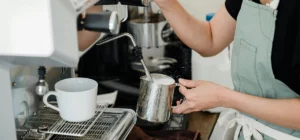Ever dreamed of owning your own café? With more than 10,000 coffee shops in the UK alone, more entrepreneurs are making their dreams come true; but be under no illusions that this is a competitive market.
Believe it or not, you don’t need a king’s ransom behind you to open a café. Instead, many choose to lease a commercial property to use their café. Yes, you’re renting, but you don’t need to fuss about buying a building or existing business from scratch.
Here’s what to know about buying a leasehold café.
What is included in a leasehold café?
Buying a leasehold café is a smart option for newcomers to the industry. With the average Brit drinking 528 cups of coffee yearly, there’s a thirsty market. But what’s included in your lease?
In short, it depends on the lease. The only guarantee is that you gain the right to operate a café from the premises for a set period in exchange for paying a pre-agreed rental amount to the landlord who owns the property.
What else you get essentially depends on whether you’re taking over an existing café or leasing a premises to turn into a café. In the former situation, you might get the Goodwill of the current café and all the fixtures and fittings (for an extra price).
On the other hand, if you’re leasing an empty space to use as a café, you might be starting from scratch.

The process of buying a leasehold café
Buying a leasehold café is straightforward enough. Most of your time will be spent creating a shortlist of suitable locations and analysing each to see which matches your vision.
Take the time to visit each café on your shortlist and arrange a viewing. This might be with an agency selling the leasehold or the leaseholder themselves. Some of the issues to consider during your viewing include:
- Location
- Local competition
- Available fixtures and fittings
- Redecoration costs
- Kitchen space
- Available kitchen equipment
- Lease terms
Whichever makes the most sense for you will depend on your goals for your café. However, it’s also ideal to conduct basic due diligence into the lease before going any further to avoid wasting your own time and money.
Start your Cafe Business Journey with us
So, assuming you’ve found a prime target, what happens next?
Step one – Make an offer
Make an offer on the premium the leaseholder is asking for. What this offer is depends on how much you want to pay and what you think your costs will be to get the café ready to open. Expect to negotiate with the leaseholder over the price, so provide yourself with some wiggle room.
Step two – Consult your solicitor
If your offer is accepted, approach a solicitor to manage the legal aspects. Transferring a lease is a legal process and shouldn’t be handled without a solicitor, as they’ll deal with everything from Heads of Terms to the Memorandum of Sale.
The seller will also have their legal team who will communicate with yours to ensure their needs are taken care of, too. If there’s an agency and a landlord, three different solicitors might be involved in the process.
Step three – Approval and due diligence
The landlord must approve the transaction and the sale of the lease. Expect the landlord to conduct due diligence and ask for documentation. These are usually bank and trade references to show that you’re capable of paying the rent and you’ve got enough money behind you.
You’ll then need to sign the legally binding contractual documents to transfer the lease and complete the final transaction. Expect it to take anywhere from six to 10 weeks, assuming there are no snags.
Costs involved in buying a leasehold café
There are significant costs in purchasing a leasehold café, so it’s wise to conduct due diligence before making an offer. Many of the costs involved can’t be recovered if you discover something is wrong at the last minute.
The primary costs you can expect to pay include:
- Your solicitor’s fees.
- The landlord’s solicitor’s fees.
- The premium for the lease (the biggest expense).
- Rental deposit.
- Advance rent.
- Stock/fixtures and fittings (if available separately).

What to look out for in a café or coffee shop lease
Leases can be daunting documents, but they’re there for your protection. You’ve likely got a solicitor to explain everything to you, but knowledge is power, so it’s good to understand everything yourself.
Here are some core areas to concentrate on:
- Term – The term is the initial term of your lease. It may also include a renewal option without renegotiating brand-new lease terms.
- Rent – The rent is how much you pay every month. Compare it to other properties in the area to see if it’s fair, and monitor the lease for permissible annual increases.
- Common Costs – Also known as outgoings, these are the costs you’re responsible for, such as security, cleaning, building improvements and proper maintenance of common areas.
- Insurance – Tenants are always liable for insurance. However, your lease will outline the types of insurance you must have, such as liability insurance.
- Fit Out – A leasehold café might be fitted out and ready to go. In all cases, it’s your responsibility to manage the fit-out. However, your lease may also require you to reverse any changes or refurbishments when you leave.
- Permitted Use – Permitted use is what the premises can be used for. Double-check that your lease allows you to open a café and check for issues like permitted opening times and noise levels.
- Exclusivity – If a leasehold café is part of a larger building or shopping centre, you might want an exclusivity clause. An exclusivity clause prohibits any competition from opening up in the same building and damaging your business.
Buying a leasehold café doesn’t have to be complicated, but you do need specialised legal support on your side to guarantee that your lease works with you, not against you. If you’re ready to make your café dreams come true, check out our latest leasehold café listings or contact Cogogo for support today.

